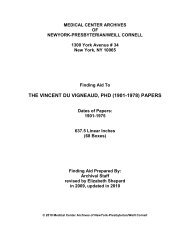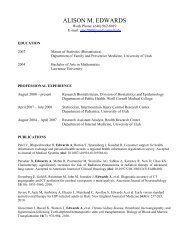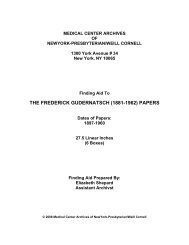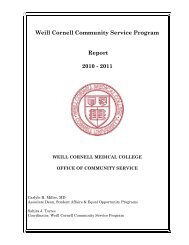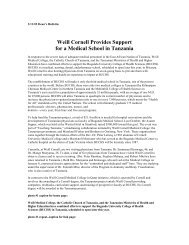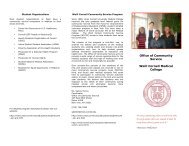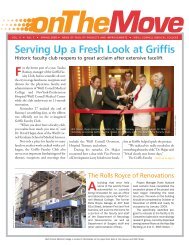Weillcornellmedicine - Weill Medical College - Cornell University
Weillcornellmedicine - Weill Medical College - Cornell University
Weillcornellmedicine - Weill Medical College - Cornell University
You also want an ePaper? Increase the reach of your titles
YUMPU automatically turns print PDFs into web optimized ePapers that Google loves.
Bench to Bedside<br />
Elizabeth Nabel, MD ’81, leads the fight<br />
against diseases of the heart, lungs,<br />
and blood<br />
Only about fifty children<br />
worldwide have Hutchinson-<br />
Gilford progeria syndrome.<br />
The genetic disorder is as<br />
deadly as it is rare: its victims<br />
almost always die of a heart attack or<br />
stroke before age fifteen. But research on<br />
the syndrome by cardiologist Elizabeth<br />
Nabel, MD ’81, is offering insight into the<br />
world’s number-one killer: heart disease.<br />
And for Nabel, that’s just a sideline.<br />
Since 2005 Nabel has been director of<br />
the NIH’s National Heart, Lung, and Blood<br />
Institute (NHLBI), overseeing an extensive<br />
research portfolio that aims to prevent,<br />
diagnose, and treat disease. Located in<br />
Bethesda, Maryland, the institute has a<br />
broad mandate, covering basic research,<br />
clinical investigations, and translation of<br />
those findings to the bedside—realms that<br />
Nabel herself has intertwined throughout<br />
her career.<br />
Perhaps the best-known example of the<br />
NHLBI’s public health efforts is the<br />
Framingham Heart Study, the longest population-based<br />
study of American adults<br />
ever conducted. Two years ago, it added a<br />
genetic component. The NHLBI has completed<br />
genotyping for its more than 14,000<br />
participants, who span three generations:<br />
grandparents enrolled in 1948, their children<br />
in 1972, and their grandchildren in<br />
2002. The NHLBI has used the Framingham<br />
work to shape its expansion into the<br />
investigation of genetic markers of heart<br />
disease in African American, Latino, and<br />
Asian communities. (It has also begun a<br />
genomics program in a large population of<br />
asthma patients.) “Researchers have already<br />
found new markers for genetic risk for<br />
heart disease that will, over time, find their<br />
way into clinical practices, so people can be<br />
counseled about their genetic risk,” says<br />
Nabel, who received the <strong>Medical</strong> <strong>College</strong>’s<br />
alumni award of distinction at Commencement<br />
2008.<br />
Surgery, not cardiology, first captured<br />
Nabel’s imagination as a medical student.<br />
But <strong>Weill</strong> <strong>Cornell</strong>’s then-head of surgery<br />
and his colleagues didn’t think there was a<br />
role for women in the field. “It was<br />
quite rough,” Nabel says. “There was<br />
only one woman in the surgical residency,<br />
and she did not have an easy<br />
experience.” At the same time, Nabel<br />
knew she wanted a satisfying home<br />
life. “I didn’t see how a career in surgery<br />
would be compatible with having<br />
a family,” she says, “particularly<br />
in an environment that wasn’t conducive<br />
to women.”<br />
So she turned to cardiology—at<br />
the time, an intervention-oriented<br />
subspecialty of internal medicine. At<br />
Boston’s Brigham and Women’s<br />
Hospital, she completed a residency<br />
in internal medicine followed by a<br />
clinical and research fellowship in cardiovascular<br />
medicine. Nabel and her husband,<br />
whom she met when she was a resident and<br />
he was her intern, took academic positions<br />
at the <strong>University</strong> of Michigan in 1987. She<br />
rose through the ranks to become chief of<br />
cardiology, joining the NHLBI in 1999 as<br />
scientific director of clinical research.<br />
As a researcher, Nabel has been investigating<br />
vascular smooth muscle cell biology<br />
for twenty years. In the Eighties she successfully<br />
used angioplasty to treat patients with<br />
blocked coronary arteries. But the technique<br />
was still in its infancy, and many blockages<br />
recurred—so Nabel founded a basic science<br />
lab to understand the biology of lesions<br />
that repopulated arteries. In the process, she<br />
became an expert in smooth muscle cells.<br />
“They form the backbone of blood vessels,”<br />
Nabel says. “Their job is to constrict or<br />
dilate the vessels as a way of regulating<br />
blood flow through an artery or vein.”<br />
When an artery is injured, she explains, the<br />
cells lose the ability to contract but gain the<br />
ability to replicate—and their proliferation,<br />
along with vessel inflammation, leads to<br />
arterial blockages.<br />
Recently, Nabel has been collaborating<br />
with Francis Collins, MD, PhD, former<br />
director of the National Human Genome<br />
Research Institute, to understand why children<br />
with Hutchinson-Gilford progeria<br />
syndrome get heart disease. They’ve dis-<br />
Elizabeth Nabel, MD ’81<br />
NIH<br />
covered that the genetic mutation leads to<br />
production of a protein, progerin, that disrupts<br />
the nuclear membrane of cells, causing<br />
vascular smooth-muscle cells to “drop<br />
out” of blood vessels, leading to maladaptive<br />
vascular remodeling where vessels<br />
clog, causing heart attack and stroke—<br />
findings that shed light on the causes of<br />
common cardiovascular disease in the general<br />
population and also hold promise for<br />
treatment. “We believe that defects in vascular<br />
smooth-muscle stem cells make them<br />
fail to proliferate in a timely manner to<br />
repopulate the blood vessel,” Nabel says.<br />
“This may provide us with insights into<br />
new molecular targets for heart disease<br />
treatment.”<br />
Until then, the NHLBI continues to<br />
push for prevention. It plans to create eight<br />
to ten global “centers of excellence” that<br />
will focus on primary and secondary prevention<br />
of heart and lung diseases. So far,<br />
programs are planned for China, India, the<br />
Middle East, Africa, South America, and<br />
Central America. Over time, Nabel says, the<br />
programs could top the Framingham study<br />
in helping scientists to gain a better understanding<br />
of the global nature of heart disease.<br />
“When we have an impact on<br />
individual and public health in this country<br />
and worldwide,” Nabel says, “it makes me<br />
proudest of the institute’s work.”<br />
— Susan Kelley<br />
WINTER 2008/09 21



